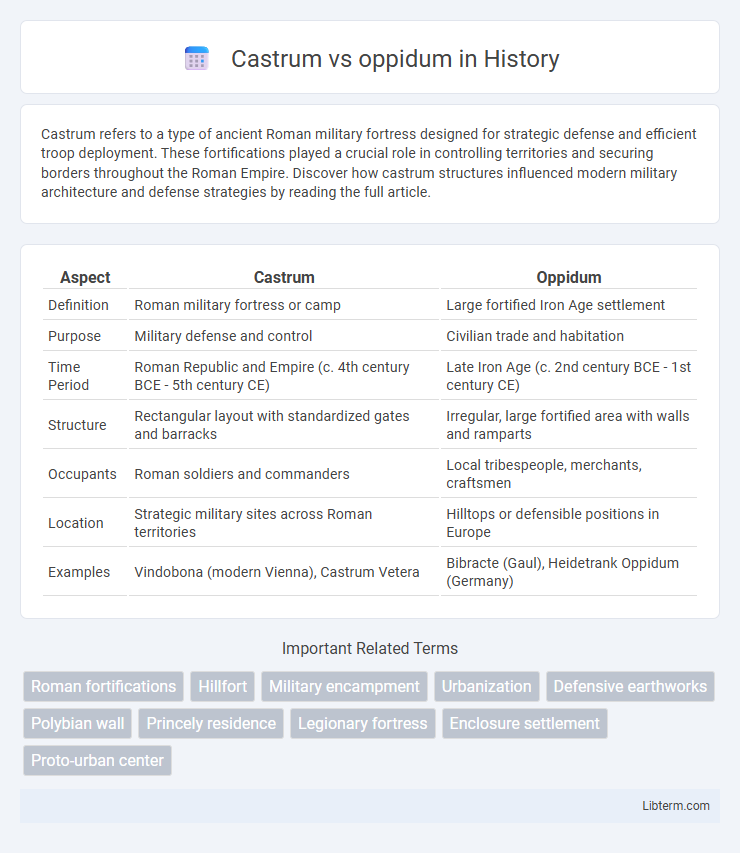Castrum refers to a type of ancient Roman military fortress designed for strategic defense and efficient troop deployment. These fortifications played a crucial role in controlling territories and securing borders throughout the Roman Empire. Discover how castrum structures influenced modern military architecture and defense strategies by reading the full article.
Table of Comparison
| Aspect | Castrum | Oppidum |
|---|---|---|
| Definition | Roman military fortress or camp | Large fortified Iron Age settlement |
| Purpose | Military defense and control | Civilian trade and habitation |
| Time Period | Roman Republic and Empire (c. 4th century BCE - 5th century CE) | Late Iron Age (c. 2nd century BCE - 1st century CE) |
| Structure | Rectangular layout with standardized gates and barracks | Irregular, large fortified area with walls and ramparts |
| Occupants | Roman soldiers and commanders | Local tribespeople, merchants, craftsmen |
| Location | Strategic military sites across Roman territories | Hilltops or defensible positions in Europe |
| Examples | Vindobona (modern Vienna), Castrum Vetera | Bibracte (Gaul), Heidetrank Oppidum (Germany) |
Introduction to Castrum and Oppidum
A castrum refers to a Roman military fortification characterized by rectangular layouts and defensive walls designed to house legions and secure strategic locations. In contrast, an oppidum denotes a large fortified Iron Age settlement used primarily by Celtic tribes, featuring irregular shapes adapted to natural terrain and serving as a socio-political and economic center. Both castra and oppida played crucial roles in controlling territories but differed significantly in their design, purpose, and cultural context.
Historical Origins of Castrum
Castrum originated in the Roman Republic as a fortified military camp designed to house legions and secure conquered territories, featuring standardized layouts with defensive walls, gates, and internal buildings. The term "castrum" reflects strategic military planning, contrasting with the oppidum, which were pre-Roman or Celtic fortified settlements primarily used for trade and habitation. Castra evolved into permanent military bases that influenced urban development patterns within the Roman Empire, marking a distinct role from the more civilian-focused oppida.
Historical Origins of Oppidum
Oppida originated during the late Iron Age as large fortified settlements established by Celtic tribes across Europe, primarily from the 2nd century BCE. These fortified urban centers served as political, economic, and social hubs long before the Roman castra, which were primarily military camps built to house and protect Roman legions. Unlike the Roman castrum, designed with standardized layouts and defensive walls for military purposes, oppida often grew organically with varied structures reflecting indigenous architectural styles and local governance.
Architectural Features of a Castrum
A castrum is characterized by its rectangular layout, fortified walls, and standardized internal organization featuring a grid pattern of streets, a central forum, and strategically placed gates, designed for Roman military efficiency and defense. Thick stone ramparts, ditches, and watchtowers enhance the castrum's fortifications, distinguishing it from the less regimented and often irregularly shaped oppidum. Unlike the oppidum, which developed organically as a Celtic settlement, the castrum's architectural features emphasize strategic control and rapid deployment of troops.
Structural Characteristics of an Oppidum
An oppidum features extensive earthworks, including multiple concentric ramparts and ditches designed for defense and controlling access, often spanning large areas atop elevated terrain. Unlike the smaller, modular Castrum with its standardized Roman fort design, an oppidum incorporates irregular layouts that adapt to the natural topography and accommodate civilian settlements alongside military fortifications. Its structural complexity reflects both strategic military considerations and the socio-economic functions of the community it encloses.
Strategic Purposes: Military vs. Civilian
Castrum served primarily as a Roman military fortification designed for defense, troop accommodation, and control of strategic locations such as crossroads or borders. Oppidum functioned as a civilian settlement built for trade, governance, and social activities, often located on elevated terrain for natural protection but lacking the strict military infrastructure of castra. The strategic purpose of castra centered on military dominance and rapid response, while oppida focused on economic growth and administrative organization within tribal societies.
Geographical Distribution in Ancient Europe
Castrum were primarily Roman military forts strategically located along borders and key routes across the Roman Empire, including regions of Gaul, Britain, and Hispania. Oppida, large fortified settlements of the Celtic tribes, were predominantly found in Central Europe, notably in modern-day France, Germany, and the Czech Republic. The geographical distribution reflects Roman military expansion versus indigenous tribal urbanization during the late Iron Age and early Roman period.
Cultural Significance and Social Roles
Castrum and oppidum served distinct cultural and social roles in ancient societies, with castra primarily functioning as Roman military forts that symbolized imperial power and discipline, facilitating army logistics and control. Oppida were large fortified settlements often associated with Celtic tribes, acting as centers of trade, political administration, and cultural identity, fostering community cohesion and local governance. The cultural significance of castra lay in their role as instruments of conquest and Romanization, whereas oppida embodied indigenous social organization and economic exchange before and during Roman expansion.
Archaeological Evidence and Discoveries
Castrum and oppidum represent distinct types of ancient settlements, with archaeological evidence highlighting their different functions and structures. Excavations of castra reveal well-organized military forts with defensive walls, barracks, and roads, reflecting Roman military engineering precision. Oppida, by contrast, uncover large fortified civilian centers with complex layouts including marketplaces, workshops, and residential areas, indicating their role as economic and social hubs in the late Iron Age Europe.
Legacy and Influence on Modern Fortifications
Castrum and oppidum represent distinct types of ancient fortified settlements, with castra primarily serving as Roman military camps featuring standardized layouts that influenced the design of modern military bases and urban planning. Oppida, large fortified Iron Age settlements, showcased advanced defensive techniques such as ramparts and ditches, elements echoed in contemporary fortification strategies and landscape architecture. The legacy of castra lies in systematic military engineering and grid organization, while oppida contribute to the understanding of civilian defense systems, both shaping modern fortification concepts and urban development.
Castrum Infographic

 libterm.com
libterm.com